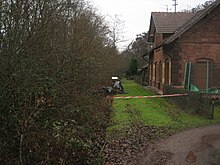Tiefenthal (Pfalz) train station
| Tiefenthal (Palatinate) | |
|---|---|
|
Former Tiefenthal station at the beginning of 2016
|
|
| Data | |
| Operating point type | Breakpoint |
| opening | 1895 |
| Conveyance | 1954 |
| Architectural data | |
| Architectural style | Neo-renaissance |
| location | |
| City / municipality | Tiefenthal |
| country | Rhineland-Palatinate |
| Country | Germany |
| Coordinates | 49 ° 32 '52 " N , 8 ° 5' 20" E |
| Railway lines | |
|
|
| Railway stations in Rhineland-Palatinate | |
The train station Tiefenthal (Pfalz) was the train station of the Rhineland-Palatinate local community Tiefenthal . From 1895 it was the only the way stop on the railway line Ebertsheim-Hettenleidelheim that from that of green city to Eisenberg and from 1932 until after Enkenbach leading Eis Valley Railway branches. Passenger traffic came to a standstill as early as 1954, freight traffic followed in 1987. The former station building is a listed building .
location
The station was located in the north-western part of the local community, far from its settlement area, not far from the boundary with the town of Eisenberg (Palatinate) on the right bank of the Seltenbach . In its immediate vicinity there are mainly agricultural areas. Across the way on the other side of the river and already on the Eisenberg district is the Seltenbach settlement .
history
The Eisenberg station , which since 1876 was the end point of the coming of Green City Eis Valley Railway, was next to the local urban industrial plants for the clay pits in neighboring Hettenleidelheim important. Since the transport caused problems due to the difficult topographical conditions, plans arose to provide this with a rail connection. Due to the gradient of the road from Eisenberg to Hettenleidelheim, a direct extension of the railway line or a siding starting at the end of the line was ruled out. On January 1, 1895, the Ebertsheim – Hettenleidelheim railway branching off the Eistal line was initially opened exclusively for freight traffic and opened for passenger traffic on May 1 of that year. A stopping point was subsequently set up at the level of the community of Tiefenthal .
At the beginning of the 20th century, like all other stations in the Palatinate, the station received platform closures. During this time, the station was managed by the Neustadt Operations and Building Inspectorate and was part of the Grünstadt railway maintenance department .
In 1922 the station was incorporated into the newly established Ludwigshafen Reich Railway Directorate . In the course of the dissolution of the Ludwigshafen management, he changed to the area of responsibility of the Mainz management on April 1, 1937; at that time he was subordinate to the works office (RBA) Neustadt.
The German Federal Railroad (DB), which was responsible for rail operations from 1949, incorporated the station into the Mainz Federal Railroad Directorate , which allocated all of the railway lines within the newly created federal state of Rhineland-Palatinate . Passenger traffic on the Ebertsheim – Hettenleidelheim line was stopped on October 3, 1954. In 1987, freight traffic along the route was also given up. The tracks were dismantled in 1990.
investment
The listed entrance building is a sandstone block building with one and a half floors, stylistically assigned to the neo-renaissance . It was built in 1894. It is now used as a residential building. The track bed in the catchment area of the station is now overgrown with bushes and the former platform is partially overgrown with grass.
traffic
passenger traffic
With the start of passenger traffic in 1895, continuous trains ran along the route to Hettenleidelheim to Grünstadt. The passenger transport itself always played a subordinate role due to the remote location of the stop. In addition, there were trains between Ebertsheim and Hettenleidelheim that connected the route between Grünstadt and Eisenberg. The latter, however, often failed. When the Eistalbahn was connected to Enkenbach in 1932, there were no connecting trips; from then on all trains ran through to Grünstadt; at that time there were about four pairs of trains on this route. In 1944 there were six pairs of trains on the route Grünstadt – Hettenleidelheim, with one train going through to Hettenleidelheim Tiefenthal without stopping. Passenger traffic between Ebertsheim and Hettenleidelheim finally ended in 1954.
Freight transport
At the beginning of the 20th century a freight train ran daily on the Ludwigshafen – Grünstadt – Eisenberg – Hettenleidelheim route.
Web links
literature
- Heinz Sturm: The Palatinate Railways (= publications of the Palatinate Society for the Advancement of Science. Volume 53). New edition. pro MESSAGE, Ludwigshafen am Rhein 2005, ISBN 3-934845-26-6 .
Individual evidence
- ↑ a b c General Directorate for Cultural Heritage Rhineland-Palatinate (Ed.): Informational directory of cultural monuments - Bad Dürkheim district. Mainz 2020, p. 89 (PDF; 5.1 MB).
- ↑ a b c schrankenposten.de: The history of the Eistalbahn Grünstadt - Enkenbach . Retrieved December 18, 2013 .
- ↑ Heinz Sturm: The Palatinate Railways . 2005, p. 265 .
- ^ Heinz Sturm: History of the Maxbahn 1855-1945 . In: Model and Railway Club Landau in der Pfalz e. V. (Ed.): 125 years of Maximiliansbahn Neustadt / Weinstr. – Landau / Pfalz . 1980, p. 75 .
- ↑ Heinz Sturm: The Palatinate Railways . 2005, p. 267 .
- ↑ bahnstatistik.de: Royal Bavarian Railway Directorate Ludwigshafen a. Rhine - Timeline: Establishments - Designations - Dissolutions . Retrieved December 18, 2013 .
- ↑ Fritz Engbarth: From the Ludwig Railway to the Integral Timed Timetable - 160 Years of the Railway in the Palatinate . 2007, p. 13 .
- ^ Klaus Detlef Holzborn: Railway Reviere Pfalz . 1993, p. 35 f .
- ↑ pkjs.de: 272 Bad Münster am Stein - Langmeil (Palatinate) - Hochspeyer . Retrieved March 3, 2016 .
- ^ Albert Mühl: The Pfalzbahn . 1982, p. 140 .

